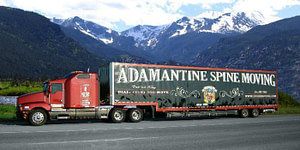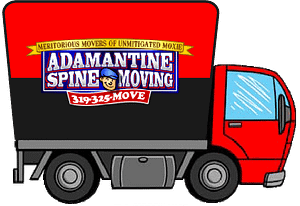Moving to a new home can be a big endeavor with a lot of shifting parts. Not only do you need to manage a big transition for you and your family, but all your possessions have to be packed up, transported, and unloaded into your new home. But what about houseplants? They’re living things and can’t simply be loaded into the back of a freezing cold (or stiflingly hot) truck like your furniture and boxes. So how do you safely move plants?

To help us understand the ins and outs of moving with plants, we recruited plant expert Suke from Moss. Moss is an urban garden boutique with locations in both downtown Iowa City and in the Newbo City Market in Cedar Rapids. Suke, a plant expert at the Iowa City location, generously offered to be our go-to resource for all the information you need to know about getting your plants safely from point A to point B.
Should I Move My Plants?
Photo Credit – Moss Blog: The Five Best Plants for Greening your Dorm Room
Suke says that, before anything else, it’s important to first determine if it’s even worth trying to move a plant. If you’re not sure you’re up to the potential challenge, then it’s best to gift them to a friend or neighbor. If you need help deciding if a plant should stay or go, she says she probably wouldn’t move anything she can easily replace.
“If I was going to be moving my plants… I would be selecting plants that have sentimental value to me; plants that are unusual or rare, that I’m unlikely to be able to find someplace else; and plants that I know are reasonably sturdy and are going to thrive in a new environment. Some plants are really fragile. Don’t carry them from here to there.They’re just going to die. It makes you sad… I probably wouldn’t move anything that I could easily replace. That would be my rule of thumb.”
According to Suke, it doesn’t make as much sense to move a plant like a pothos, which can be easily replaced and grow fairly quickly, whereas something like variegated jade is typically more worth the effort of moving, since it can take a lot longer to grow and is far more expensive to replace. However, at the end of the day you’re the one that knows the personal value of your plants. If something has sentimental value, even if it’s cheap or easy to replace, it may be worth moving it just for the personal connection.
Whatever the plant and whichever the reason, if you want them to follow you on your journey, here are a few things you’ll want to know first.
Can I Move My Plants?
Photo Credit – Moss Blog: Houseplants Gone Wild: Moving Your Houseplants Outside in the Spring
When it comes time to move, getting all your furniture and other possessions packed up for transport is a no-brainer, but what about plants? Can indoor, or outdoor, plants be transported to your new home? The answer is surprisingly complicated.
Our plant expert Suke says that legal considerations are one of the first things you need to look at before crossing any borders with your plants.
“Different states have different restrictions on plants that you can and can’t bring across their borders. California, Arizona, Florida, and Oregon are four of the toughest states. California will stop a moving van at the border and check you for plants. So make sure you check with a state’s agricultural department website before you start taking plants across the border because they will impose some pretty serious fines.”
Sometimes certain types of vegetation are prohibited, and other times it simply needs to be approved and registered. You can reference the National Plant Board for a handy guide if you plan to move your plants between states.
Once you’re sure it’s legal, you can definitely transport your plants. You’ll just want to make sure you make appropriate accommodations during travel and have a similar environment in your new home so they can properly thrive after the move.
How do I Prepare Plants For a Move
Photo Credit – Moss Blog: Room to Grow: Repotting your Houseplants
Moving plants, especially from one climate to another, can be a daunting task. The process to prepare plants for a move can begin as long as three weeks prior to your moving day. Suke from Moss says three weeks out is when you want to prune your larger plants. Anything leafy or bendable that sticks out above the pot should get trimmed to remove excess dead or dying limbs. That way there’s minimal danger of uncontrolled breakage during transit.
Two weeks before moving day is a good time to re-pot any large plants planted in a heavy or fragile pot. Moving with pots made out of material like ceramic or terracotta is a bad idea according to Suke:
“Aside from the fact that they’re really really heavy to move, the pots can break in transit… then you have a plant with its roots hanging out and dirt all over the place. So the best thing to do about two weeks before is to take your big plants out of any pots that are breakable and put them in plastic nursery pots, and you don’t have to make a big deal out of it. just pull the plant out of the old pot, stick it in the new pot, and pack some dirt around it. It’s not going to be in there permanently, but it gives it time to settle into it before you start moving it around.”
Closer to moving day, especially in warmer months, keep an eye on your plants in case they need water. Making sure they are well fed and well adjusted goes a long way to helping ease the transition to their new home.
In the last days before your move, you can begin preparing them for actual transport. Leafy plants or plants with branches can be protected by paper cones made by simply rolling paper and taping it in place so one end is pointy and the other is open – think party hats for your plants.
Your plants should be one of the last things you pack so you can make sure nothing gets stacked on top of them and that they’re allowed to stay comfortable in their typical home for as long as possible.
Smaller plants can go into a box, provided they aren’t kept out of the sun for an extended period, but the box must have holes to allow for airflow.
How Should I Transport My Plants?
Photo Credit – Moss Blog: Be the Rainstorm in the Desert (Zen and the Art of Succulent Maintenance, Part III)
There are a variety of ways to simply get your plants from point A to B, but plants are living things and need proper care. If you can’t ensure your plant will even survive the move, then there’s not much point in even getting it packed up!
If you are driving yourself, then ideally you have space in your car for your plants. If possible, they should go in your passenger seat, but if that’s not an option, then make sure there is no danger of being squashed by boxes or anything else you have packed up.
For longer trips, Suke warns not to leave your plants in the car for too long, particularly overnight:
“If you are travelling over a period of days, and this is another thing you should consider when you’re deciding what plants you’re taking with you – or how many plants you’re taking with you – don’t leave your plants in your car or in the van overnight. Get them out and bring them to your hotel room. Hang out with them. Have a beer. Relax in the middle of the trip.”
How to Acclimate My Plants to Their New Home
Moving long distances, especially if it involves a change in climate, can be a strain on your plants. Plant expert Suke stresses that maintaining consistency is key
“Plants really thrive on consistency. Consistency is key to keeping your plants alive. Every plant has its own set of needs, but being consistent is the most important thing that you can do for your plant. So if you have an Iowa acclimated plant, and you want to move it to Louisiana, that’s going to be challenging. That’s going to be difficult because any plant is going to really struggle with that change. Because it’s going to be hot, it’s going to be humid, the lights going to change, your house is going to change, everything’s going to change and plants don’t do change well.”
In order to help maintain at least a semblance of this consistency, your plants should be the very first thing to get attention once you’ve arrived at your destination and unloaded your family and pets. Try to place them in a location that has a similar environment and lighting to their old home, and let them sit for a while. They just went through the stress of a move, so there’s no need to force them to adapt to changes faster than necessary.
If they’re covered with a paper cone, that can be removed, but there’s no need to rush them into new pots – that can be handled later, once your plant has had appropriate time to adjust.
As living things, plants require extra planning, preparation, and care in order to handle the stress of a move from old home to new. If you decide that you just can’t leave one or multiple plants behind, then these tips should increase your chances of a successful move for you and your green, leafy friends.
If you have any additional questions about moving your plants, give the experts at Moss a call at (319)338-4020 or visit their website, and of course, if you’re moving to the Iowa City or Cedar Rapids area, be sure to pay them a visit once you’re ready to liven up your new home with their excellent selection of plants.




